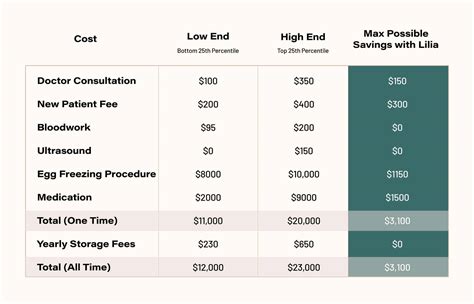The Ultimate Guide to Embryo Freezing Costs: A Comprehensive Overview
Embryo freezing, also known as cryopreservation, is a groundbreaking reproductive technology that allows individuals and couples to preserve their fertility options for the future. However, understanding the associated costs is crucial before embarking on this journey. This comprehensive guide will break down the various expenses involved in embryo freezing, helping you navigate this important decision with clarity.
What Factors Influence Embryo Freezing Costs?
The cost of embryo freezing isn't a one-size-fits-all figure. Several factors contribute to the overall expense:
-
Clinic Location: Costs vary significantly based on geographic location. Clinics in major metropolitan areas or those with higher overhead typically charge more than those in smaller towns.
-
Clinic Fees: Each fertility clinic sets its own pricing structure. Some clinics offer bundled packages, while others charge per procedure. Be sure to compare pricing from multiple clinics in your area.
-
Number of Cycles: The number of IVF cycles needed to obtain viable embryos directly impacts the cost. More cycles necessitate more medication, procedures, and monitoring.
-
Medication Costs: The cost of fertility medications can be substantial and varies depending on the individual's response to the medication and the type of medication prescribed.
-
Storage Fees: Once embryos are frozen, ongoing storage fees apply annually. These fees can accumulate over time, so understanding the long-term financial commitment is essential.
-
Insurance Coverage: Insurance coverage for embryo freezing varies widely depending on the policy and the specific circumstances. Some plans offer partial or full coverage, while others offer none. Check your policy details carefully.
How Much Does Embryo Freezing Cost? A Breakdown
Providing a precise cost is difficult without specific circumstances, but we can offer a general overview:
-
Initial IVF Cycle (including medication): Expect to pay anywhere from $12,000 to $20,000 or more per cycle. This encompasses all aspects of the IVF process, from ovarian stimulation to egg retrieval and fertilization.
-
Embryo Freezing Procedure: The actual freezing process itself usually adds a few hundred to a thousand dollars to the overall cost.
-
Annual Storage Fees: These fees typically range from $300 to $800 per year, per embryo.
-
Thawing and Transfer: Should you decide to use your frozen embryos later, the thawing and transfer procedures will incur additional costs, generally ranging from $1,000 to $3,000.
How Can I Reduce the Cost of Embryo Freezing?
Several strategies can help manage the expenses associated with embryo freezing:
-
Shop Around: Contact multiple fertility clinics and compare their pricing structures, including medication costs and storage fees.
-
Explore Financing Options: Many clinics offer financing plans to make treatment more affordable. Investigate these options thoroughly, understanding the terms and interest rates.
-
Maximize Insurance Coverage: Review your insurance policy carefully to determine the extent of coverage for IVF and embryo freezing. Some policies cover specific portions of the process.
-
Consider a Smaller Number of Embryos: Freezing a smaller number of embryos will obviously reduce the associated storage fees over time.
-
Negotiate: Don't be afraid to negotiate with clinics, especially if you're paying out-of-pocket or have a limited budget.
What are the long-term costs of embryo storage?
Long-term costs of embryo storage primarily involve ongoing annual storage fees. These fees accumulate year after year, representing a significant long-term financial commitment. The exact amount depends on the clinic's pricing and can vary, but plan for several hundred dollars annually per embryo.
What are my options if I can't afford embryo freezing?
If you can't afford embryo freezing, explore all available options such as seeking financing options through your clinic or other financial institutions. You might also consider alternative fertility preservation methods that might be more financially accessible. Contacting patient advocacy groups or fertility specialists for guidance on financial aid programs is another route to consider.
Are there any grants or financial assistance programs available to help with embryo freezing costs?
Financial assistance programs for fertility treatments, including embryo freezing, are available, but their availability and eligibility criteria vary based on factors like location, income, and insurance coverage. It’s essential to contact fertility clinics, patient advocacy groups, or research specific grants in your area to determine your eligibility.
This guide offers a comprehensive overview of embryo freezing costs. Remember to consult with your fertility specialist to discuss your individual circumstances and create a personalized financial plan. The investment in preserving your fertility is a significant one, but with careful planning and thorough research, it's possible to manage the costs effectively.

